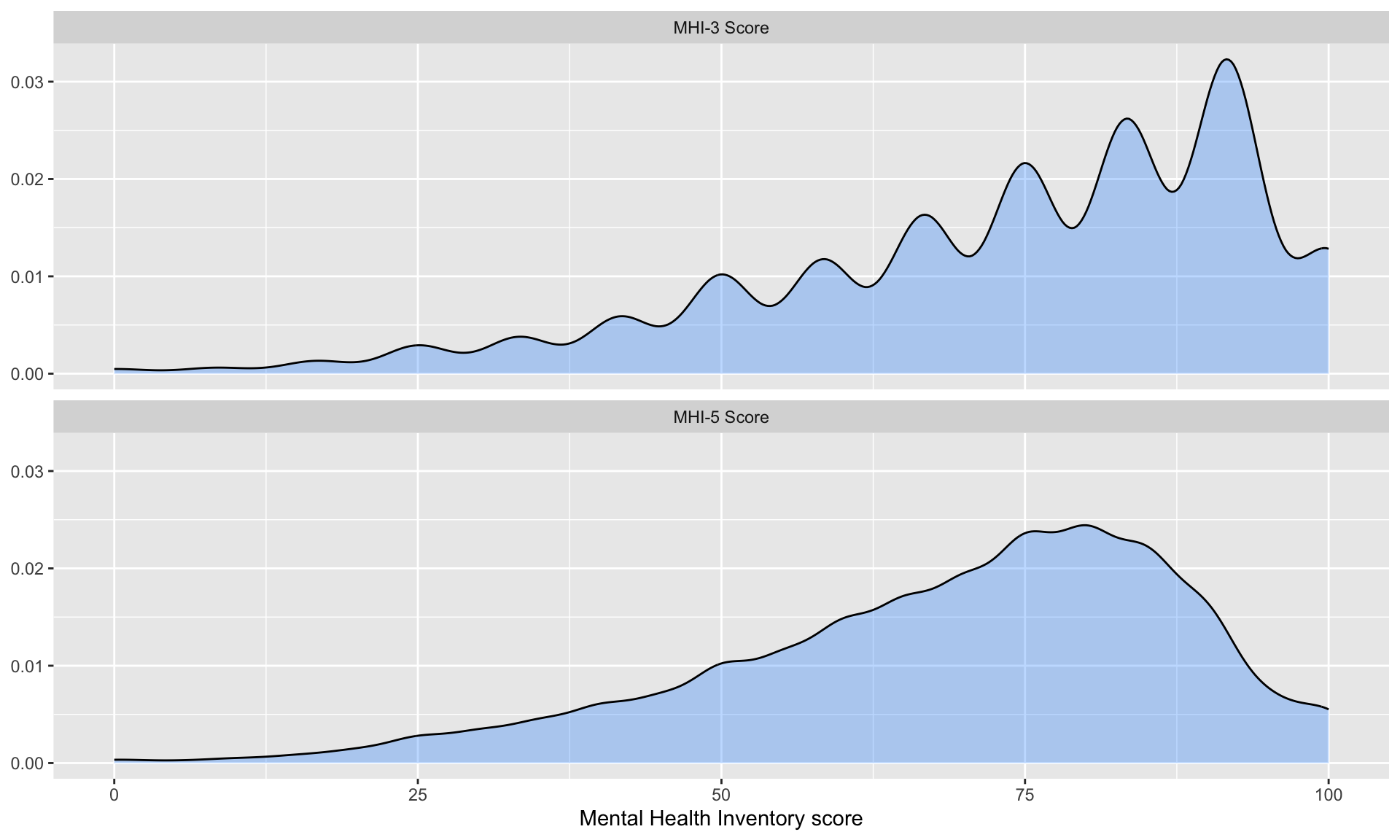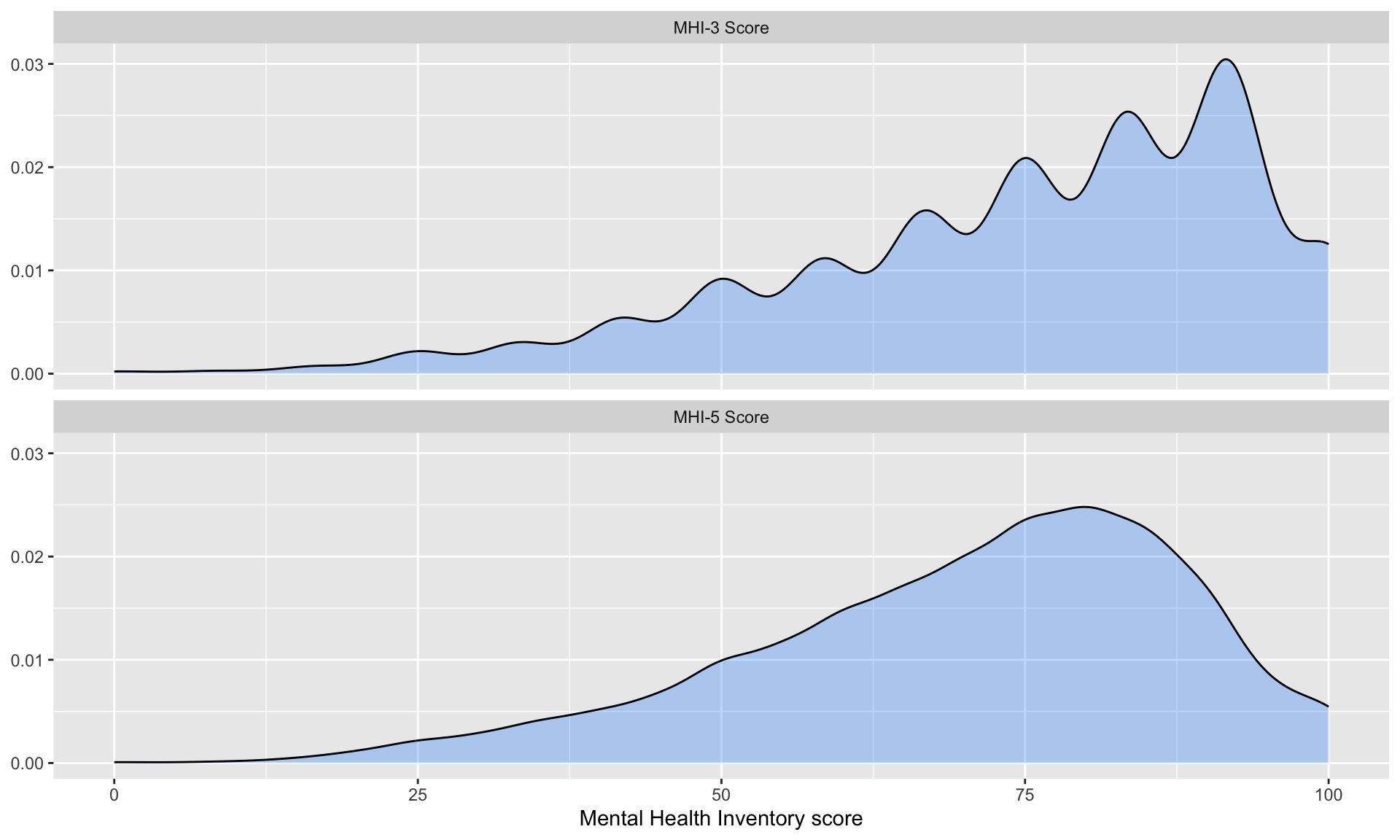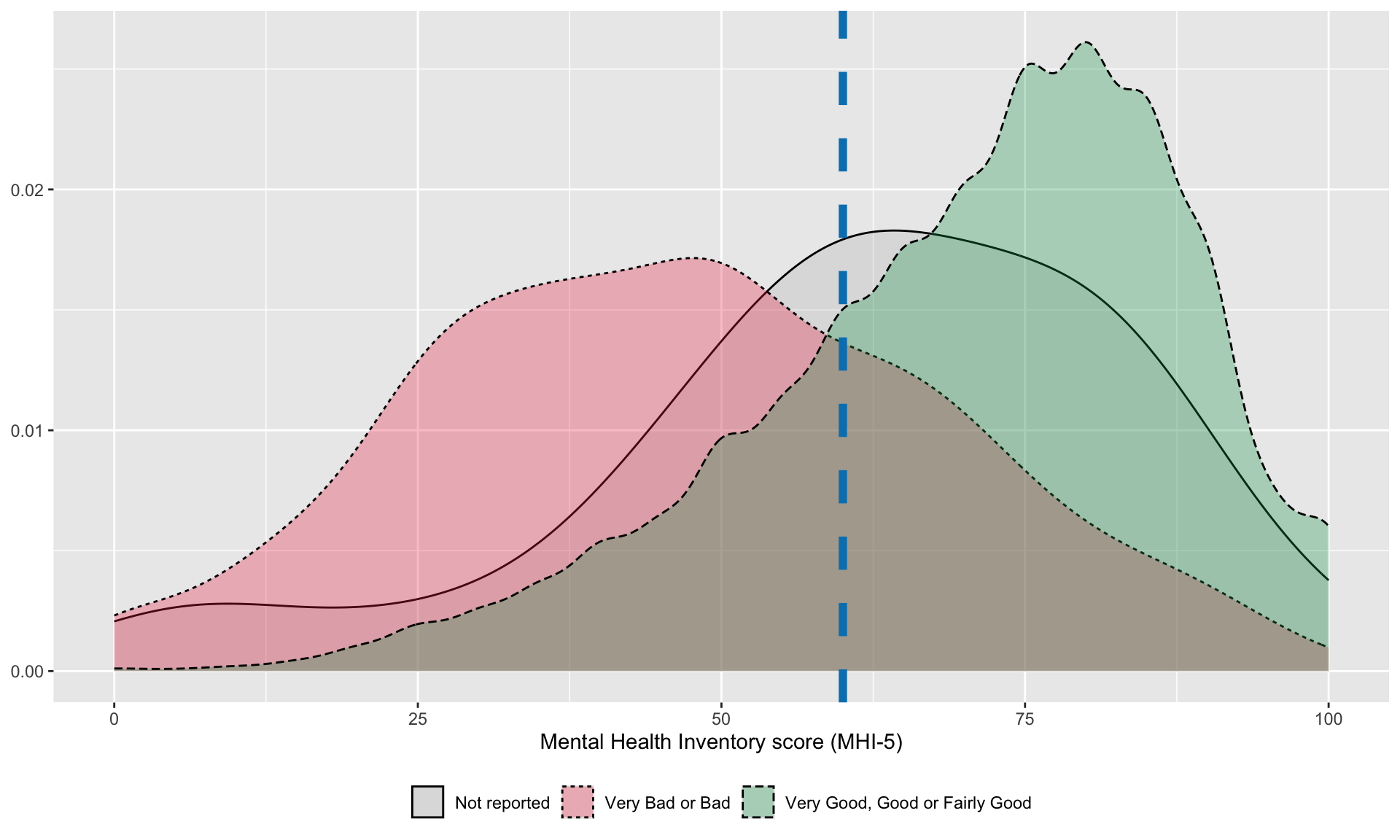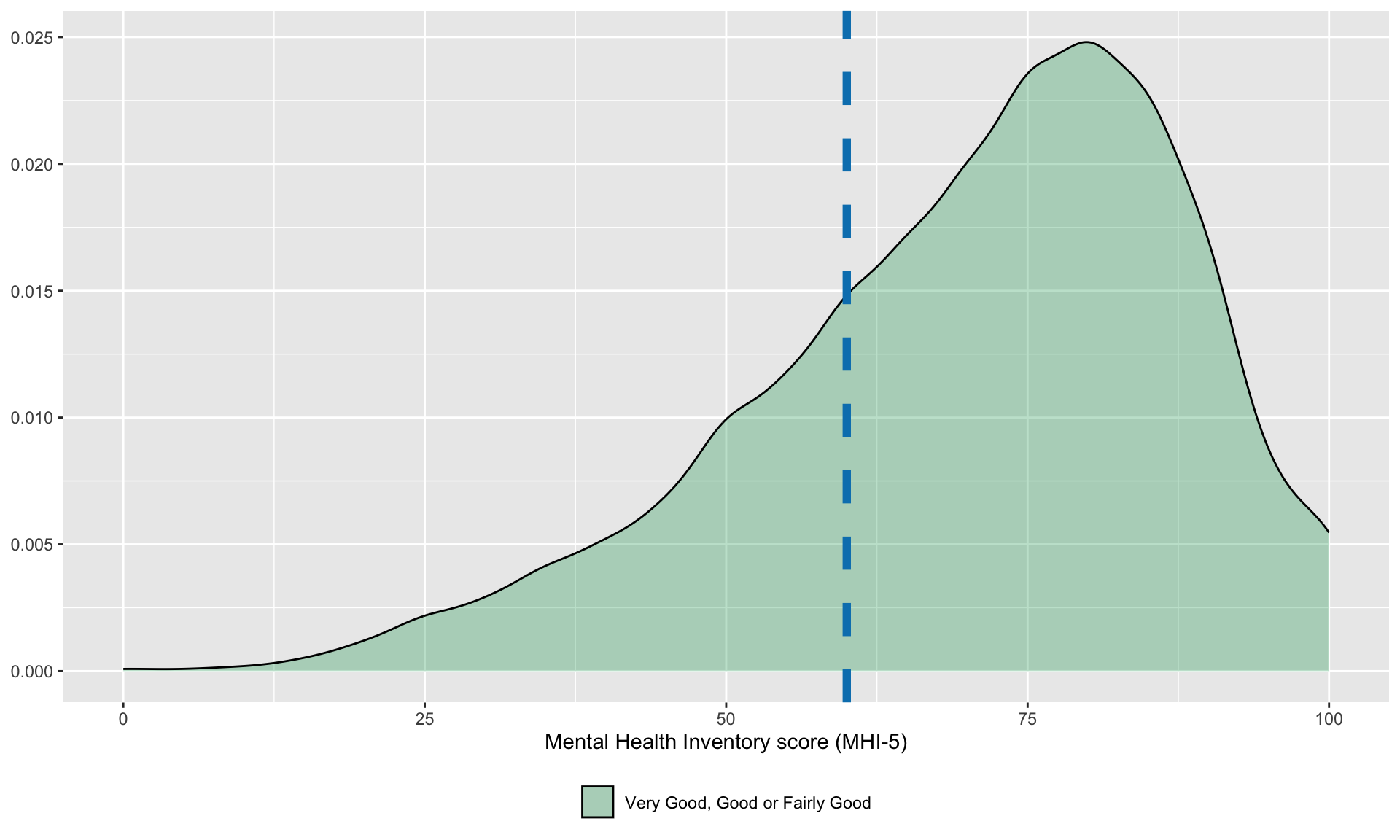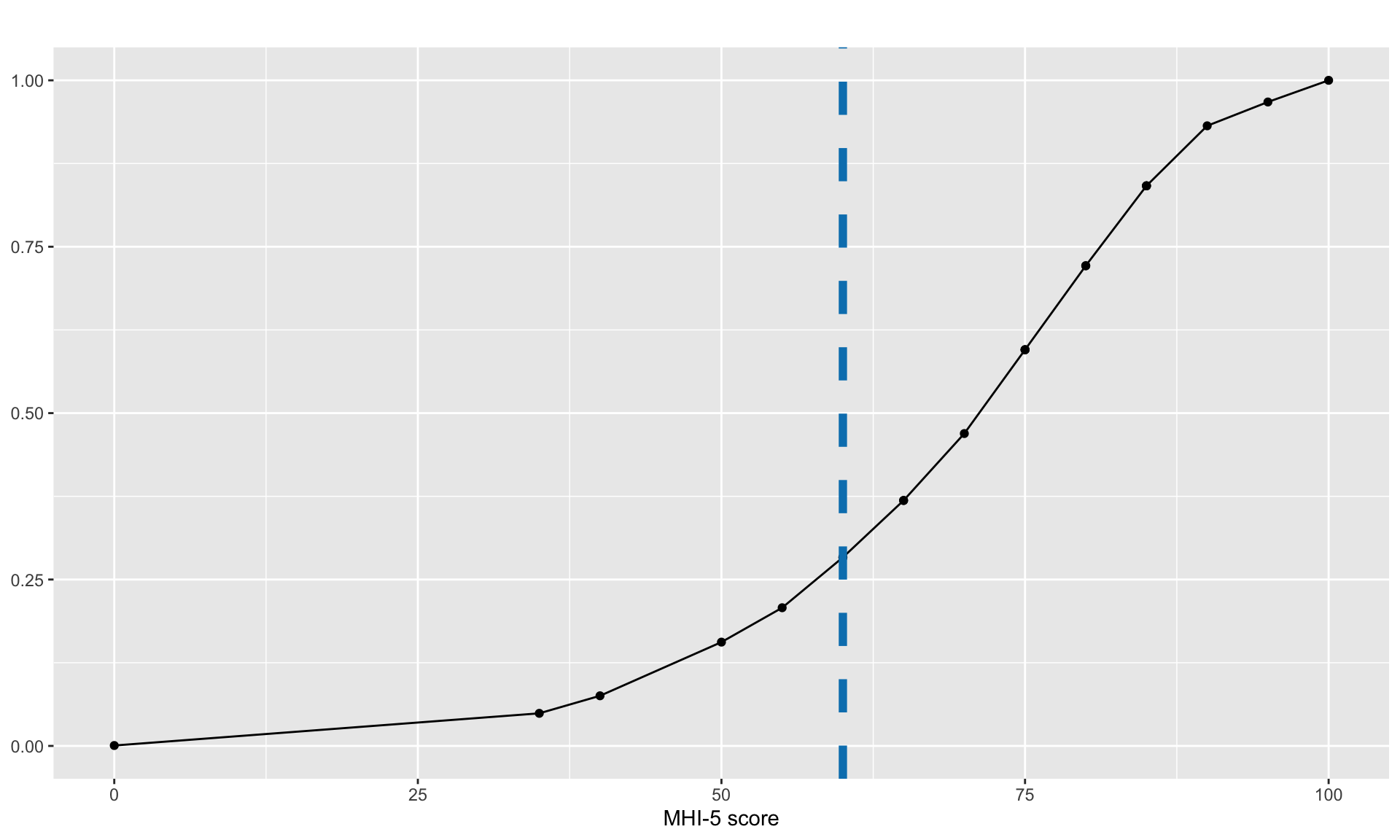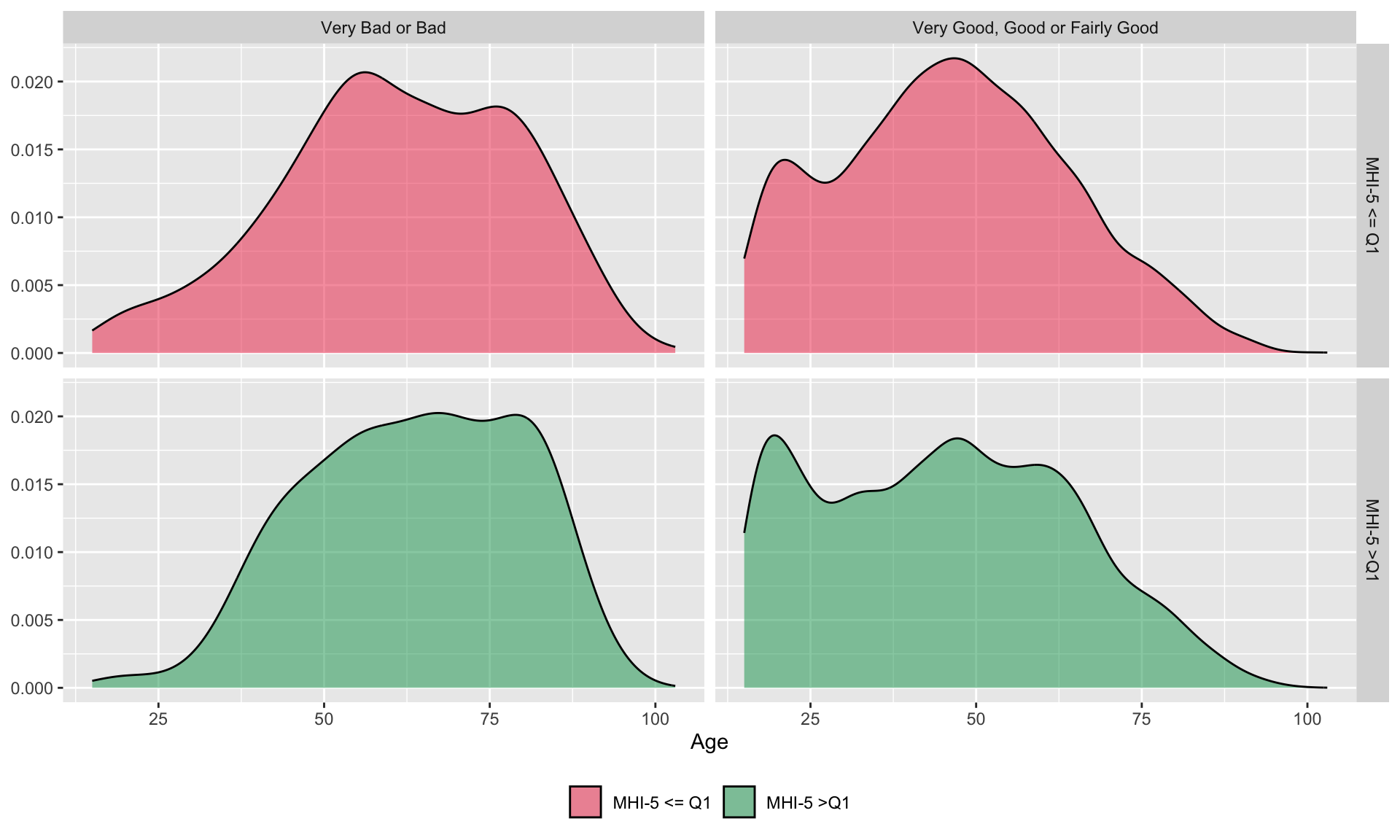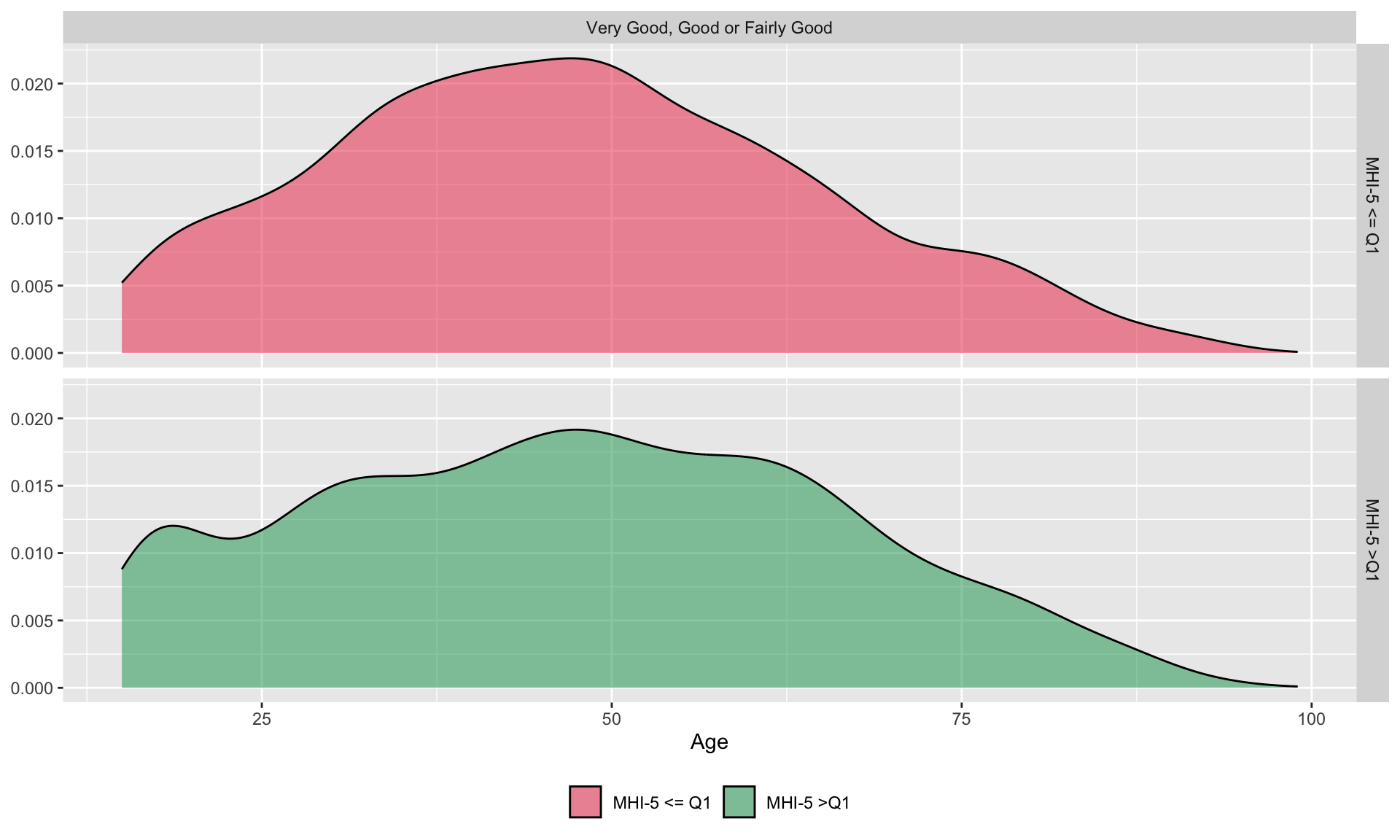|
Long-term condition (SNIIRAM) (n = 11,459) Yes
|
1053 (9.19%)
|
350 (10.78%)
|
703 (8.56%)
|
|
|
Long-term condition (SNIIRAM) No
|
5157 (45%)
|
1482 (45.66%)
|
3675 (44.75%)
|
|
|
Long-term condition (SNIIRAM) No answer
|
5249 (45.81%)
|
1414 (43.56%)
|
3835 (46.69%)
|
\(< 10^{-3}\)
|
|
Exp. Outpatient (n = 6,210)
|
1290.79 (+/-1957.58)
|
1564.32 (+/-2171.4)
|
1176.32 (+/-1849.12)
|
\(< 10^{-3}\)
|
|
Exp. General Practitioner (n = 6,210)
|
119.41 (+/-132.07)
|
147.97 (+/-148.21)
|
107.46 (+/-122.76)
|
\(< 10^{-3}\)
|
|
Exp. Specialist (n = 6,210)
|
185.65 (+/-332.92)
|
224.58 (+/-356.23)
|
169.36 (+/-321.32)
|
\(< 10^{-3}\)
|
|
Exp. Pharmacy (n = 6,210)
|
389.49 (+/-1171.92)
|
480.54 (+/-1063.73)
|
351.38 (+/-1212.42)
|
\(< 10^{-3}\)
|
|
Exp. Physiotherapist (n = 6,210)
|
51.53 (+/-188.87)
|
65.78 (+/-206.29)
|
45.57 (+/-180.78)
|
\(< 10^{-3}\)
|
|
Exp. Nurse (n = 6,210)
|
49.13 (+/-515.82)
|
67.79 (+/-654.98)
|
41.32 (+/-444.72)
|
\(0.065\)
|
|
Exp. Dentist (n = 6,210)
|
168.14 (+/-527.46)
|
188.25 (+/-619.98)
|
159.73 (+/-483.35)
|
\(0.052\)
|
|
Exp. Equipment (n = 6,210)
|
55.18 (+/-379.09)
|
79.01 (+/-501.5)
|
45.2 (+/-313.55)
|
\(0.001\)
|
|
Exp. Transport (n = 6,210)
|
29.06 (+/-262.85)
|
44.53 (+/-290.31)
|
22.58 (+/-250.22)
|
\(0.003\)
|
|
Exp. Optical (n = 6,210)
|
108.74 (+/-228.23)
|
112.37 (+/-226.51)
|
107.22 (+/-228.96)
|
\(0.417\)
|
|
Exp. Prostheses (n = 6,210)
|
36.14 (+/-240.24)
|
39.84 (+/-240.85)
|
34.6 (+/-240)
|
\(0.433\)
|
|
Exp. Emergency w/o hospitalization (n = 6,210)
|
14.79 (+/-51.08)
|
17.95 (+/-56.84)
|
13.46 (+/-48.41)
|
\(0.002\)
|
|
Reimbursement Outpatient (n = 6,210)
|
786.87 (+/-1696.62)
|
988.53 (+/-1855.68)
|
702.49 (+/-1618.23)
|
\(< 10^{-3}\)
|
|
Reimbursement General Practitioner (n = 6,210)
|
82.59 (+/-98.99)
|
103.77 (+/-114.33)
|
73.73 (+/-90.36)
|
\(< 10^{-3}\)
|
|
Reimbursement Specialist (n = 6,210)
|
123.91 (+/-242.52)
|
154.2 (+/-277.46)
|
111.24 (+/-225.14)
|
\(< 10^{-3}\)
|
|
Reimbursement Pharmacy (n = 6,210)
|
285.64 (+/-1132.4)
|
349.75 (+/-997.31)
|
258.82 (+/-1183.44)
|
\(0.004\)
|
|
Reimbursement Physiotherapist (n = 6,210)
|
35.06 (+/-148.33)
|
45.74 (+/-171.67)
|
30.59 (+/-137.17)
|
\(< 10^{-3}\)
|
|
Reimbursement Nurse (n = 6,210)
|
43.08 (+/-490.11)
|
61.78 (+/-650.16)
|
35.25 (+/-404.62)
|
\(0.052\)
|
|
Reimbursement Dentist (n = 6,210)
|
59.41 (+/-145.46)
|
65.61 (+/-183.12)
|
56.82 (+/-126.34)
|
\(0.03\)
|
|
Reimbursement Equipment (n = 6,210)
|
45.4 (+/-359.32)
|
68.91 (+/-490.73)
|
35.56 (+/-286.51)
|
\(< 10^{-3}\)
|
|
Reimbursement Transport (n = 6,210)
|
26.38 (+/-255.6)
|
40.06 (+/-277.18)
|
20.65 (+/-245.82)
|
\(0.006\)
|
|
Reimbursement Optical (n = 6,210)
|
2.71 (+/-6.19)
|
2.9 (+/-6.4)
|
2.63 (+/-6.1)
|
\(0.125\)
|
|
Reimbursement Prostheses (n = 6,210)
|
12.21 (+/-97.45)
|
13.47 (+/-87.2)
|
11.68 (+/-101.44)
|
\(0.509\)
|
|
Reimbursement Emergency w/o hospitalization (n = 6,210)
|
11.77 (+/-40.3)
|
14.23 (+/-44.44)
|
10.75 (+/-38.39)
|
\(0.002\)
|
|
Co-payment Outpatient (n = 6,210)
|
233.46 (+/-267.55)
|
281.28 (+/-300.5)
|
213.45 (+/-249.82)
|
\(< 10^{-3}\)
|
|
Co-payment General Practitioner (n = 6,210)
|
27.68 (+/-34.23)
|
33.27 (+/-37.55)
|
25.35 (+/-32.46)
|
\(< 10^{-3}\)
|
|
Co-payment Specialist (n = 6,210)
|
33.17 (+/-48.64)
|
39.54 (+/-58.57)
|
30.51 (+/-43.55)
|
\(< 10^{-3}\)
|
|
Co-payment Pharmacy (n = 6,210)
|
90.93 (+/-135.01)
|
115.41 (+/-161.3)
|
80.69 (+/-120.91)
|
\(< 10^{-3}\)
|
|
Co-payment Physiotherapist (n = 6,210)
|
14.66 (+/-55.24)
|
17.67 (+/-53.15)
|
13.4 (+/-56.05)
|
\(0.005\)
|
|
Co-payment Nurse (n = 6,210)
|
5.25 (+/-73.46)
|
5.07 (+/-22.47)
|
5.33 (+/-86.28)
|
\(0.9\)
|
|
Co-payment Dentist (n = 6,210)
|
21.94 (+/-57.5)
|
24.83 (+/-72.93)
|
20.73 (+/-49.6)
|
\(0.01\)
|
|
Co-payment Equipment (n = 6,210)
|
8.47 (+/-52.41)
|
8.55 (+/-42.09)
|
8.44 (+/-56.17)
|
\(0.941\)
|
|
Co-payment Transport (n = 6,210)
|
2.14 (+/-22.18)
|
3.77 (+/-33.73)
|
1.46 (+/-14.86)
|
\(< 10^{-3}\)
|
|
Co-payment Optical (n = 6,210)
|
1.64 (+/-3.88)
|
1.71 (+/-4.05)
|
1.61 (+/-3.81)
|
\(0.336\)
|
|
Co-payment Prostheses (n = 6,210)
|
4.5 (+/-17.17)
|
4.94 (+/-17.54)
|
4.31 (+/-17.01)
|
\(0.186\)
|
|
Co-payment Emergency w/o hospitalization (n = 6,210)
|
2.75 (+/-11.46)
|
3.42 (+/-13.09)
|
2.47 (+/-10.7)
|
\(0.003\)
|
|
Extra-fees Outpatient (n = 6,210)
|
243.97 (+/-502.54)
|
263.07 (+/-534.9)
|
235.98 (+/-488.21)
|
\(0.053\)
|
|
Extra-fees General Practitioner (n = 6,210)
|
5.35 (+/-29.2)
|
6.32 (+/-30.45)
|
4.94 (+/-28.66)
|
\(0.09\)
|
|
Extra-fees Specialist (n = 6,210)
|
24.87 (+/-106.37)
|
26.48 (+/-88.94)
|
24.2 (+/-112.87)
|
\(0.441\)
|
|
Extra-fees Pharmacy (n = 6,210)
|
0.13 (+/-6.07)
|
0.01 (+/-0.31)
|
0.18 (+/-7.22)
|
\(0.317\)
|
|
Extra-fees Physiotherapist (n = 6,210)
|
0.79 (+/-12.78)
|
1.19 (+/-17.81)
|
0.62 (+/-9.94)
|
\(0.108\)
|
|
Extra-fees Nurse (n = 6,210)
|
0.02 (+/-0.47)
|
0.01 (+/-0.22)
|
0.02 (+/-0.53)
|
\(0.476\)
|
|
Extra-fees Dentist (n = 6,210)
|
86.79 (+/-356.01)
|
97.79 (+/-399.81)
|
82.18 (+/-335.94)
|
\(0.115\)
|
|
Extra-fees Equipment (n = 6,210)
|
1.31 (+/-15.56)
|
1.56 (+/-17.41)
|
1.21 (+/-14.72)
|
\(0.411\)
|
|
Extra-fees Transport (n = 6,210)
|
0.3 (+/-13.23)
|
0.33 (+/-9.08)
|
0.3 (+/-14.62)
|
\(0.936\)
|
|
Extra-fees Optical (n = 6,210)
|
104.39 (+/-220.94)
|
107.76 (+/-219.08)
|
102.97 (+/-221.73)
|
\(0.436\)
|
|
Extra-fees Prostheses (n = 6,210)
|
19.43 (+/-187.28)
|
21.42 (+/-188.62)
|
18.6 (+/-186.74)
|
\(0.589\)
|
|
Extra-fees Emergency w/o hospitalization (n = 6,210)
|
0.02 (+/-0.5)
|
0.02 (+/-0.5)
|
0.02 (+/-0.51)
|
\(0.624\)
|
|
Deduct. Outpatient (n = 6,210)
|
26.26 (+/-26.95)
|
31.2 (+/-29.63)
|
24.19 (+/-25.46)
|
\(< 10^{-3}\)
|
|
Deduct. General Practitioner (n = 6,210)
|
3.78 (+/-4.15)
|
4.6 (+/-4.81)
|
3.43 (+/-3.79)
|
\(< 10^{-3}\)
|
|
Deduct. Specialist (n = 6,210)
|
3.47 (+/-4.82)
|
4.13 (+/-5.69)
|
3.2 (+/-4.38)
|
\(< 10^{-3}\)
|
|
Deduct. Pharmacy (n = 6,210)
|
12.78 (+/-14.84)
|
15.37 (+/-16.06)
|
11.69 (+/-14.16)
|
\(< 10^{-3}\)
|
|
Deduct. Physiotherapist (n = 6,210)
|
1.03 (+/-3.36)
|
1.18 (+/-3.36)
|
0.96 (+/-3.36)
|
\(0.02\)
|
|
Deduct. Nurse (n = 6,210)
|
0.78 (+/-3.69)
|
0.94 (+/-4.31)
|
0.72 (+/-3.39)
|
\(0.034\)
|
|
Deduct. Dentist (n = 6,210)
|
0.01 (+/-0.16)
|
0.02 (+/-0.27)
|
0 (+/-0.09)
|
\(0.004\)
|
|
Deduct. Transport (n = 6,210)
|
0.23 (+/-1.69)
|
0.38 (+/-2.37)
|
0.17 (+/-1.3)
|
\(< 10^{-3}\)
|
|
Deduct. Emergency w/o hospitalization (n = 6,210)
|
0.24 (+/-0.95)
|
0.28 (+/-1.03)
|
0.22 (+/-0.91)
|
\(0.012\)
|
|
No. Medical Sessions General Pract. (n = 6,210)
|
4.51 (+/-4.58)
|
5.63 (+/-5.36)
|
4.05 (+/-4.13)
|
\(< 10^{-3}\)
|
|
No. Medical Sessions Specialist (n = 6,210)
|
3.37 (+/-4.47)
|
4.11 (+/-5.49)
|
3.05 (+/-3.93)
|
\(< 10^{-3}\)
|
